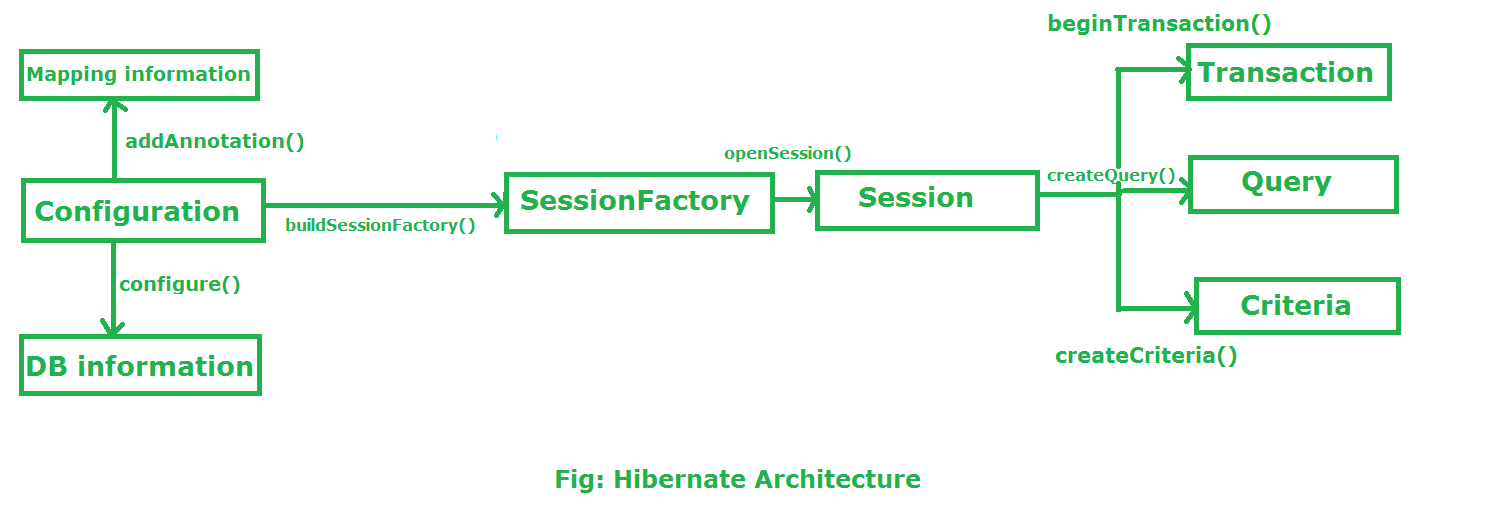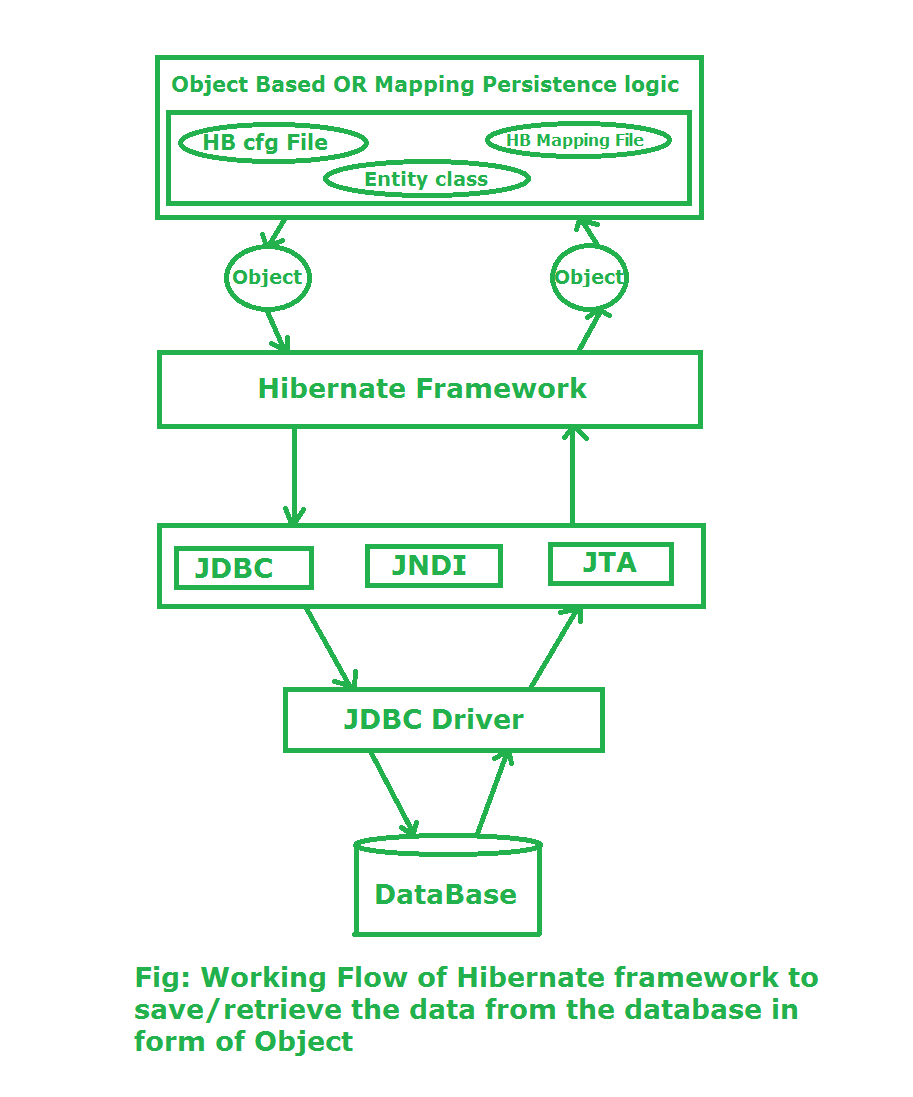Hibernate Architecture
Last Updated :
15 Nov, 2022
Prerequisites: Introduction of Hibernate Hibernate: Hibernate is a framework which is used to develop persistence logic which is independent of Database software. In JDBC to develop persistence logic we deal with primitive types. Whereas Hibernate framework we use Objects to develop persistence logic which are independent of database software. Hibernate Architecture:  Configuration:
Configuration:
- Configuration is a class which is present in org.hibernate.cfg package. It activates Hibernate framework. It reads both configuration file and mapping files.
It activate Hibernate Framework
Configuration cfg=new Configuration();
It read both cfg file and mapping files
cfg.configure();
- It checks whether the config file is syntactically correct or not.
- If the config file is not valid then it will throw an exception. If it is valid then it creates a meta-data in memory and returns the meta-data to object to represent the config file.
SessionFactory:
- SessionFactory is an Interface which is present in org.hibernate package and it is used to create Session Object.
- It is immutable and thread-safe in nature.
buildSessionFactory() method gathers the meta-data which is in the cfg Object.
From cfg object it takes the JDBC information and create a JDBC Connection.
SessionFactory factory=cfg.buildSessionFactory();
Session:
- Session is an interface which is present in org.hibernate package. Session object is created based upon SessionFactory object i.e. factory.
- It opens the Connection/Session with Database software through Hibernate Framework.
- It is a light-weight object and it is not thread-safe.
- Session object is used to perform CRUD operations.
Session session=factory.buildSession();
Transaction:
- Transaction object is used whenever we perform any operation and based upon that operation there is some change in database.
- Transaction object is used to give the instruction to the database to make the changes that happen because of operation as a permanent by using commit() method.
Transaction tx=session.beginTransaction();
tx.commit();
Query:
- Query is an interface that present inside org.hibernate package.
- A Query instance is obtained by calling Session.createQuery().
- This interface exposes some extra functionality beyond that provided by Session.iterate() and Session.find():
- A particular page of the result set may be selected by calling setMaxResults(), setFirstResult().
- Named query parameters may be used.
Criteria:
- Criteria is a simplified API for retrieving entities by composing Criterion objects.
- The Session is a factory for Criteria. Criterion instances are usually obtained via the factory methods on Restrictions.
Flow of working during operation in Hibernate Framework : Suppose We want to insert an Object to the database. Here Object is nothing but persistence logic which we write on java program and create an object of that program. If we want to insert that object in the database or we want to retrieve the object from the database. Now the question is that how hibernate save the Object to the database or retrieve the object from the database. There are several layers through which Hibernate framework go to achieve the above task. Let us understand the layers/flow of Hibernate framework during performing operations:  Stage I: In first stage, we will write the persistence logic to perform some specific operations to the database with the help of Hibernate Configuration file and Hibernate mapping file. And after that we create an object of the particular class on which we wrote the persistence logic. Stage II:In second stage, our class which contains the persistence logic will interact with the hibernate framework where hibernate framework gives some abstraction do perform some task. Now here the picture of java class is over. Now Hibernate is responsible to perform the persistence logic with the help of layers which is below of Hibernate framework or we can say that the layers which are the internal implementation of Hibernate. Stage III:In third stage, our hibernate framework interact which JDBC, JNDI, JTA etc to go to the database to perform that persistence logic. Stage IV & V:In fourth & fifth stage, hibernate is interact with Database with the help of JDBC driver. Now here hibernate perform that persistence logic which is nothing but CRUD operation. If our persistence logic is to retrieve an record then in the reverse order it will display on the console of our java program in terms of Object.
Stage I: In first stage, we will write the persistence logic to perform some specific operations to the database with the help of Hibernate Configuration file and Hibernate mapping file. And after that we create an object of the particular class on which we wrote the persistence logic. Stage II:In second stage, our class which contains the persistence logic will interact with the hibernate framework where hibernate framework gives some abstraction do perform some task. Now here the picture of java class is over. Now Hibernate is responsible to perform the persistence logic with the help of layers which is below of Hibernate framework or we can say that the layers which are the internal implementation of Hibernate. Stage III:In third stage, our hibernate framework interact which JDBC, JNDI, JTA etc to go to the database to perform that persistence logic. Stage IV & V:In fourth & fifth stage, hibernate is interact with Database with the help of JDBC driver. Now here hibernate perform that persistence logic which is nothing but CRUD operation. If our persistence logic is to retrieve an record then in the reverse order it will display on the console of our java program in terms of Object.
Like Article
Suggest improvement
Share your thoughts in the comments
Please Login to comment...